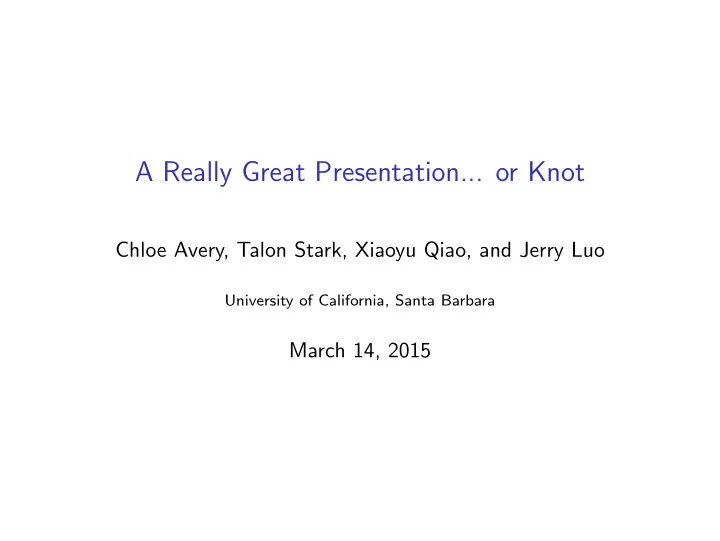

A Really Great Presentation... or Knot Chloe Avery, Talon Stark, Xiaoyu Qiao, and Jerry Luo University of California, Santa Barbara March 14, 2015
What is a Knot? A mathematical knot is a closed path in 3-dimensional space that doesn’t self-intersect.
Knot Diagrams In two dimensional space, we represent knots in the following way:
The Unknot The unknot is a knot that can be untangled to become a loop with no crossings.
Complicated Unknot It can be remarkably difficult to determine if a given knot is actually the unknot:
Crossing Game One interesting thing we can do with knots is play games on them ! To do this, take any knot:
Crossing Game Suppose you “forget” what happens at all of the crossings: We will use this picture as our game board.
Crossing Game Players take turns making one of the following moves:
Crossing Game On our diagram, this looks like the following: r
Crossing Game There are two players: ◮ Player U Objective: Create an unknot. ◮ Player K Objective: Create a knot that isn’t an unknot.
Example
Winning Strategy for 3 1 Does Player K have a winning strategy?
Winning Strategy for 3 1 Frayed Knot.
Winning Strategy for 3 1 Due to symmetry, the first move is arbitrary.
Winning Strategy for 3 1 Also due to symmetry, there are only two possibilities for the second move.
Winning Strategy for 3 1 This gives us four possibilities for the third move.
Winning Strategy for 3 1 Recall that for Player U to win, the game must result in an unknot and for Player K to win, the game must result in a knot (in this case the trefoil).
Winning Strategy for 3 1 Let’s start by assuming that Player K (in red) goes first: On the second move, Player U (in blue) can simply pick the move on the left and force Player K to make a move that creates the unknot.
Winning Strategy for 3 1 So if Player K goes first, Player U has a winning strategy.
Winning Strategy for 3 1 Now, let’s consider the case where Player U (in blue) goes first: Regardless of the move that Player K makes in the second move, Player U is always able to make a move that creates the unknot.
Winning Strategy for 3 1 So if Player U goes first, Player U has a winning strategy.
Winning Strategy for 3 1 Therefore, we have shown the following: regardless of who goes first, Player U has a winning strategy.
Braid Knots Another kind of knot that we looked at is called a braid knot:
Winning Strategy for Braid Knots Claim: Player U wins for Braid Knots. (Note: Braid Knots have an odd number of crossings.)
Winning Strategy for Braid Knots Examples of Braid Knot Diagrams:
Winning Strategy for Braid Knots Observation: when one strand goes over the other twice, it reduces to a braid knot with 2 fewer crossings.
Winning Strategy for Braid Knots Observation: When one strand goes over the other twice, it reduces to a braid knot with 2 fewer crossings.
Winning Strategy for Braid Knots Therefore, Player U can continue to force this until the braid knot becomes the trefoil: We know that Player U has a winning strategy for the trefoil. So U wins!
Winning Strategy for Odd Tri-Braid Knots Consider the following kind of knot, called an “Odd-Tri-Braid” knot:
Winning Strategy for Odd Tri-Braid Knots
Winning Strategy for Odd Tri-Braid Knots
Winning Strategy for Odd Tri-Braid Knots With the exception of one move in Region 1, Player U can always make a strand go over another twice. This reduces that region by 2 crossings.
Winning Strategy for Odd Tri-Braid Knots Player U can continue to reduce the knot until there is a single move without a match for reduction. We have two possibilities: In either case, Player U has a winning strategy.
Future Work
Winning Strategy for 4 1 The second player has a winning strategy on the following knot:
Future Work We are looking into finding a general strategy for knots like these:
Winning Strategy for 7 4 The first player has a winning strategy on the following knot:
Future Work We are looking into finding a general strategy for knots like these:
Questions?
References ◮ Winning Ways for your Mathematical Plays by: Elwyn R. Berlekamp, John H. Conway, and Richard K. Guy ◮ www . math . washington . edu / morrow / papers / will − thesis . pdf ◮ faculty . smcm . edu / sganzell / papers / untangle − 2 . pdf ◮ www . csuchico . edu / math / mattman / NSF / Lecturenotes . pdf ◮ www . math . washington . edu / ∼ mathcircle / mathhour / talks 2014 / henrich − slides . pdf ◮ The Knot Book by Colin C. Adams ◮ Knots, Links, Braids and 3-Manifolds: An Introduction to Low-Dimensional Topology by V.V. Prasolov and A.B. Stossinsky ◮ An Introduction to Knot Theory by W.B. Raymond Lickorish
Recommend
More recommend